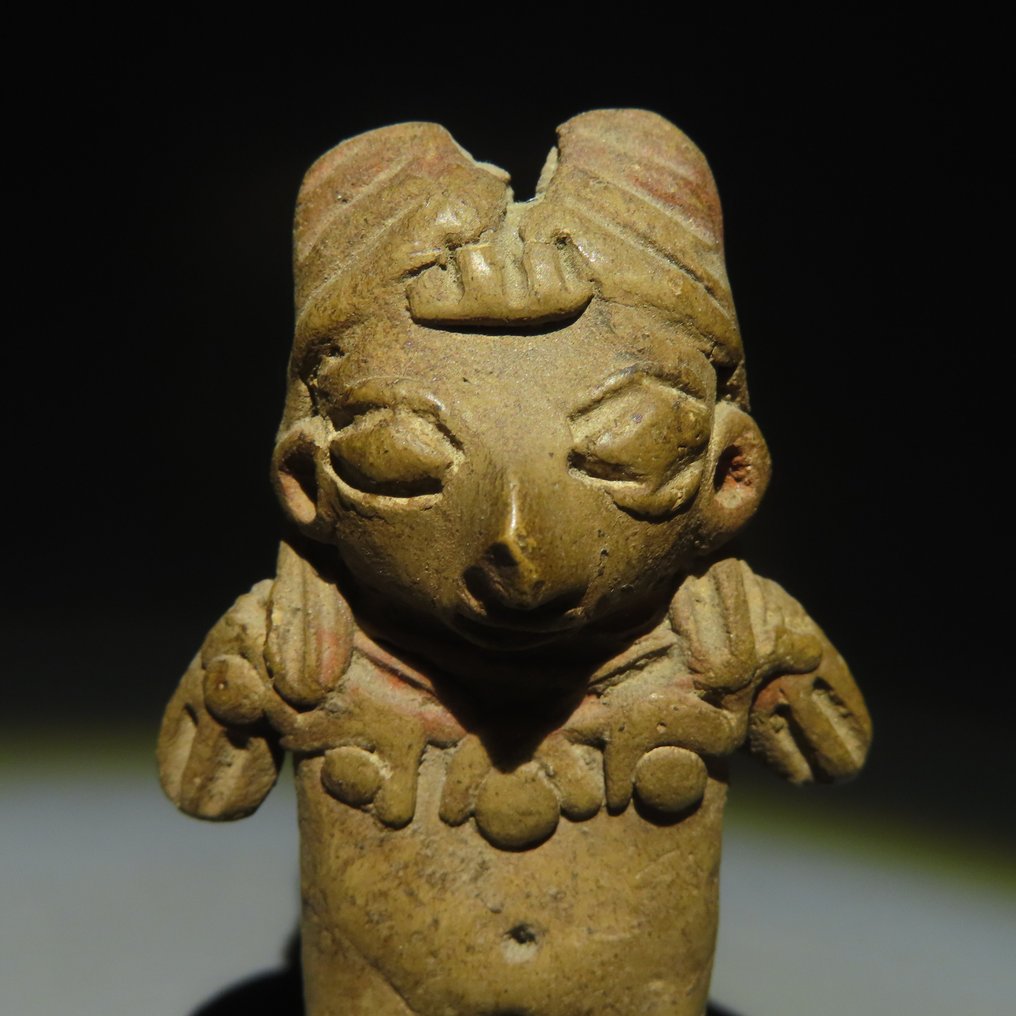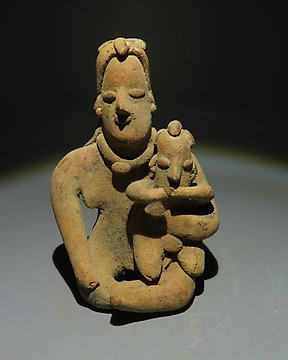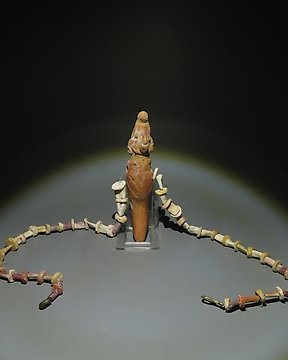Great object. Really beautiful. Quick delivery. Excellent.
Fordítás megtekintéseChupícuaro, Guanajuato, Mexikó Terrakotta Ábra. Kr.e. 400-1000. 6 cm H. Spanyol importengedély.
Nr. 88173581



Figure.
Chupícuaro, Guanajuato, Mexico, 400 BC-1000 AD.
Terracotta.
6 cm height.
PROVENANCE: Romy Rey private collection, London, United Kingdom.
CONDITION: Good condition.
DESCRIPTION:
This culture’s territory was located in what is now the far north of Mexico, in the area of the states of Jalisco, Nayarit, Colima, Guerrero, Michoacán, and particularly Guanajuato. The region comprises three types of natural landscape: plateaus, volcanic mountain ranges, and grasslands. The grasslands are semi-tropical while the other areas have a temperate climate.
The Chupícuaro culture had its origins in the Ticomán culture, but emerged in the late pre-classical and early classical periods. Its ceramic tradition is related to those of El Arbolillo and Zacatenco, and the use of the stirrup handle has led to speculation that they may have been connected to Northern Peruvian cultures, in which this style of ceramic handle was common.
The Chupícuaro produced polished ceramics decorated mainly with black and cream geometrical designs on a red background. The ceramic forms they made include bowls with conical bases, dishes, and some bottles with stirrup handles. Multicolored human figurines were also made and decorated with the same designs used on their dishes, with barely discernable facial features. The best known Chupícuaro female figurines are the “diagonal eyed” figures, which were occasionally painted in vivid colors but usually left unpainted and finely decorated with appliqués of clay and clay slip. These figures are mostly represented nude and with clearly female anatomy, but some pieces are wearing elaborate headdresses and clothing, and all sport unique hairstyles and body decorations. The figurines date from the last stage of the ancient tradition of female representations that began with the Tlatilco culture. The Chupícuaro also produced ceramic flutes, ocarinas, and earpieces, and used bone and seashell to make a wide variety of ornaments.
Notes:
- The piece includes authenticity certificate.
- The piece includes Spanish Export License.
- The seller guarantees that he acquired this piece according to all national and international laws related to the ownership of cultural property. Provenance statement seen by Catawiki.
Az eladó története
Figure.
Chupícuaro, Guanajuato, Mexico, 400 BC-1000 AD.
Terracotta.
6 cm height.
PROVENANCE: Romy Rey private collection, London, United Kingdom.
CONDITION: Good condition.
DESCRIPTION:
This culture’s territory was located in what is now the far north of Mexico, in the area of the states of Jalisco, Nayarit, Colima, Guerrero, Michoacán, and particularly Guanajuato. The region comprises three types of natural landscape: plateaus, volcanic mountain ranges, and grasslands. The grasslands are semi-tropical while the other areas have a temperate climate.
The Chupícuaro culture had its origins in the Ticomán culture, but emerged in the late pre-classical and early classical periods. Its ceramic tradition is related to those of El Arbolillo and Zacatenco, and the use of the stirrup handle has led to speculation that they may have been connected to Northern Peruvian cultures, in which this style of ceramic handle was common.
The Chupícuaro produced polished ceramics decorated mainly with black and cream geometrical designs on a red background. The ceramic forms they made include bowls with conical bases, dishes, and some bottles with stirrup handles. Multicolored human figurines were also made and decorated with the same designs used on their dishes, with barely discernable facial features. The best known Chupícuaro female figurines are the “diagonal eyed” figures, which were occasionally painted in vivid colors but usually left unpainted and finely decorated with appliqués of clay and clay slip. These figures are mostly represented nude and with clearly female anatomy, but some pieces are wearing elaborate headdresses and clothing, and all sport unique hairstyles and body decorations. The figurines date from the last stage of the ancient tradition of female representations that began with the Tlatilco culture. The Chupícuaro also produced ceramic flutes, ocarinas, and earpieces, and used bone and seashell to make a wide variety of ornaments.
Notes:
- The piece includes authenticity certificate.
- The piece includes Spanish Export License.
- The seller guarantees that he acquired this piece according to all national and international laws related to the ownership of cultural property. Provenance statement seen by Catawiki.
Az eladó története
- 823
- 11
- 1
Superbe objet, Service d'Arqueologia Ancient Art excellent et rapide. Jaume Bagot toujours parfait .
Fordítás megtekintéseTodo perfecto gracias
Fordítás megtekintéseNice item all ok A+++
Fordítás megtekintéseThank you for this Oinochoe, one question: did you as promised read my post!
Fordítás megtekintéseExcellent translation, and very prompt delivery. Imperfect packaging. A significant crack of the board that had not been described in the original post of the item.
Fordítás megtekintéseAlways a great pleasure!
Fordítás megtekintéseFine quality, good service. Thanks.
Fordítás megtekintéseMuy amables, muy bien todo. Gracias
Fordítás megtekintéseAlles bestens
Fordítás megtekintéseexactly as described and shipped safely and punctually.
Fordítás megtekintéseschnelle Lieferung sehr sichere Verpackung alles bestens
Fordítás megtekintésetres bel objet je le recherchai depuis longtemps envoi rapide et protégé je pense qu'il y aura d'autres achats avec ce vendeur merci +++++++
Fordítás megtekintéseEinfach nur toll
Fordítás megtekintéseTodo perfecto
Fordítás megtekintéseottimo
Fordítás megtekintéseperfetto
Fordítás megtekintésetop oggetto bellissimo grazie 💯💯💯💯💯💯 :-)
Fordítás megtekintéseI bought this beautiful artifact together with artifact from Mr. Bagot but although it is clearly stated on his shipping page that when purchasing multiple artifacts i paid the double package costs
Fordítás megtekintéseI bought this beautiful artifact together with artifact from Mr. Bagot but although it is clearly stated on his shipping page that when purchasing multiple artifacts i paid the double package costs
Fordítás megtekintéseBel objet, bien emballé. Parfait.
Fordítás megtekintésewonderful faiece and very fast shipping.thanks a lot
Fordítás megtekintéseJ Bagot es un profesional excelente. Sus artículos son de gran calidad, se incluye la documentación necesaria y el embalaje se realiza con esmero. Le recomiendo encarecidamente.
Fordítás megtekintéseo envio foi bastante rápido, obrigado.
Fordítás megtekintéseSono molto soddisfatto grazie.
Fordítás megtekintése- 823
- 11
- 1
Great object. Really beautiful. Quick delivery. Excellent.
Fordítás megtekintése








